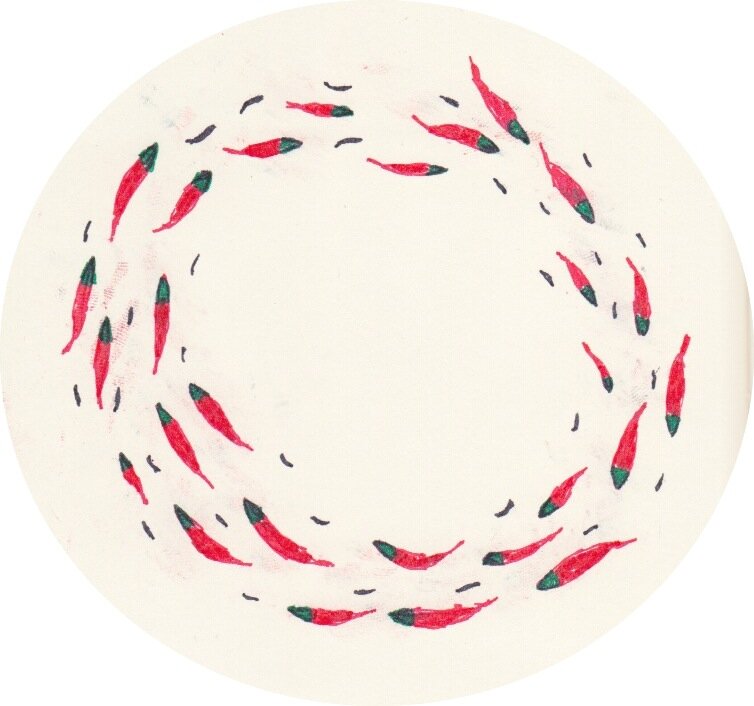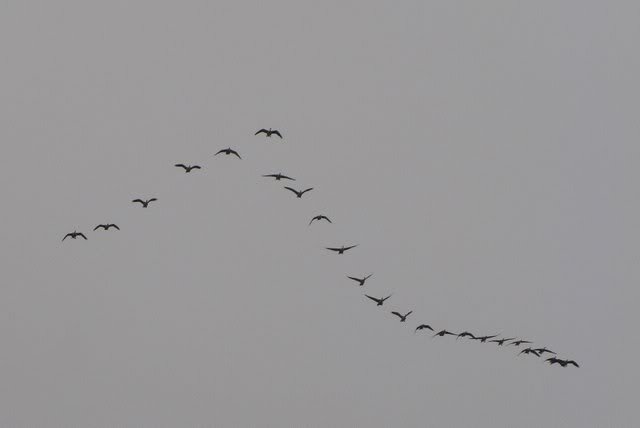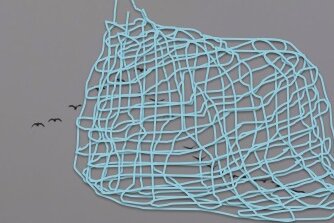So we’ve only known this for how long?
Salmon are a cycle.
They come and go like seasons;
like tides;
like the weather.
Or… as is happening in the north right now — like birds.
The other day I saw the first few robins starting to brave the several feet of snow still in our yard in BC’s central interior. I also saw the first hawk of the year a few days ago.
Yesterday afternoon, in a stop at the grocery story my daughter spotted something like this, way above us:
Canada Geese on their way north.
And so what else comes with spring?
Well… on the coast, salmonberry bushes will start to blossom.
Some folks suggest the bush got its name because First Nations folks ate salmon with the berries… others suggest its because the berries look like small clusters of eggs.
Growing up on Haida Gwaii, I had it suggested to me that the link was that when the berries started to ripen it meant it was time to go fishing for sockeye…
(I also learned — the hard way (on several occasions) — that gorging on salmonberries can lead to some gastric distress… kind of like some of the debates surrounding salmon…)
_ _ _ _ _ _
And then last week the media jumped on the story about scientists “proving” the deep-reaching links of the salmon cycle… This story out of the Ottawa Citizen, of all places:
Salmon may live in the water, but a new study shows they help shape the forest.
A study of 50 watersheds in the Great Bear Rainforest on British Columbia’s central coast says bears, fish-catching wolves and other predators haul huge amounts of salmon into the forest that provide a potent “nutrient subsidy” that drives plant growth in the surrounding forest.
Nitrogen released by the fish favours some plants – such as the aptly named salmonberry -while pushing out other species, researchers from Simon Fraser University published in the journal Science’s Friday edition.
“Salmon are important to us not just because of their value in fisheries and for food, but they also can be having quite significant impacts on our surroundings,” says biologist John Reynolds, co-author of the four-year study.
…
Salmon in the Great Bear Rainforest are so plentiful that the region’s wolves have specialized to catch the fish live as they swim through shallow waters on their way to spawning streams, says Reynolds.
The wolves, like the bears, leave a lot of the fish behind.
“The wolves typically eat only the head or the brain,” he says.
Working with the Heiltsuk First Nation the researchers counted how many salmon migrated up different streams -and found “thousands” of fish spawning in some of the coastal streams, many which had not been surveyed before, says Reynolds.
Bears, wolves and other predators “can transfer more than 50 per cent of the salmon to the forest,” they report. The rest of the fish, which die after spawning, either rot along the stream banks or are washed downstream.
To assess the impact, they looked at stream chemistry and what grew in surrounding forests.
“We looked at all plants that we encountered, from lichens to shrubs,” says Reynolds.
They found species, such as salmonberry and stink currant, thriving along streams with plenty of salmon. Plants such as blueberry and false azalea prefer nutrient poor soils and were less common.
_ _ _ _ _ _
As I pointed out in a last week… it’s great to see some of these sorts of things hitting the mainstream media. However, it should be remembered that this sort of thing has been ‘known’ for a long, long, long time throughout the range of Pacific salmon… Not “hidden” as the article suggests… (maybe hidden to those that understand natural cycles… or those that isolate things into little categories… kind of like government departments that separate “managing” bears from “managing” salmon…)
State of the Salmon: Salmon Atlas -- Original Pacific salmon distribution
.
As a more recent example, in their 1999 paper: . Jeff Cederholm and colleagues state:
Pacific salmon also have been considered important vectors for returning significant amounts of nutrients from the northern Pacific Ocean back to land, representing a unique way to move nutrients upstream. This subject has attracted attention from scientists and economists throughout the Pacific Rim.
Consider Japan’s Edo era (1603-1867), when people believed that a streamside forest could provide fish with numerous benefits such as cover, nutrients, and food. This belief remained in the minds of people living near waterfronts or forests after the Meiji Restoration (1868).
When the first forest act of Japan was introduced at the beginning of the twentieth century, it contained an article ordering conservation of uo-tsuki-rin, literally “fish attracting forest.” Using anecdotal information, Sibatani (1996) suggested that uo-tsuki-rin may operate in the opposite direction: “The land near rivers is well fertilized by the ocean nutrients brought by ascending (spawning) salmon, which causes the forests to thrive.
_ _ _ _ _ _
So let’s think about this for a few seconds…
We have this great cycle that has gone on for thousands and thousands and thousands of years.
Salmon spawn then die, babies are born in the spring, head to the ocean, cycle through the North Pacific, head home, spawn, die.
The death feeds everything around — including the babies, and the cycle begins again.
And so on, and so on, and so on….
But then in the late 1800s, a new factor enters the equation… a cycle of another kind: an economic cycle with largely one sole purpose. Profit.
And so the equation is something akin to this:
.
So in sticking with the analogies from the beginning… (and this isn’t very “scientific”)…
What would happen in the north if we removed 75% of the seasons?
Would we expect the “Fall” to keep producing the same amount of things we have come to expect?
_ _ _ _ _
What about the geese?
If we captured 80 – 100% would we expect the few remaining to keep producing the same numbers?
(granted some folks aren’t big fans of geese and …)
_ _ _ _ _
.
.
.
So this is the part that gets me…
There’s some apparent great “mystery” out there on why salmon populations are crashing…
There’s even a $15 – $20 million judicial inquiry going on right now over one year (2009) of crashed sockeye populations in the Fraser River: the .
Within the Commission is a whole ream of scientists scrambling to find the ‘smoking gun’… (made all the more bizarre with the monster return of Fraser sockeye last year — 2010).
_ _ _ _ _ _
If we know it’s a cycle and over the last 125 years or so we’ve done our best to obliterate the cycle — not just through overfishing — then why are fish populations, with industrial fisheries focused upon them, so “mysterious” when they collapse?
What happens if I take 75% of the gas out of your car?
What happens if take 75% of the money out of your bank account?
What happens if I cut the value of interest collected on your investments by 75%?
Or, for that fact, cut your investments by 75%? (as experienced by a few folks in the last few years).
What if we interrupted the water cycle — and harvested 75% of the rain fall in the Okanagan over the next 50 years?
A cycle is a cycle is a cycle.
If we humans decide to interrupt naturally occurring cycles by “harvesting” or “consuming” for ourselves– we’re going to have an impact.
No one puzzled all that greatly on what happened to Cod… no on puzzled all that greatly on what happened to the variety of over-harvested whales… no one is puzzling all that greatly on what’s happening to the world’s tuna populations… or even BC’s Coho populations for that fact.
And the starving grizzly bear’s of Rivers Inlet on BC’s coast?
Well… if you went to a restaurant and they only served you 25% of what you ordered — what would be the impact? (And then you had to fight all the other restaurant goers for your share of what used to be enough)
What if every time you go to the grocery store and you were only able to buy 25% of what you normally do?
I think you probably get my point…. still a mystery?








